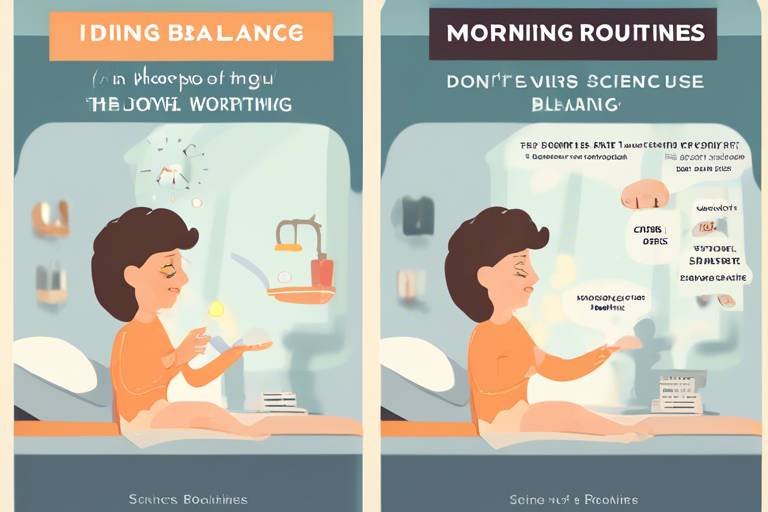How Exercise Impacts Sleep Quality - The Science
Have you ever noticed how a good workout can leave you feeling not only energized but also ready to hit the hay? It’s not just your imagination! The connection between exercise and sleep quality is a fascinating topic that has garnered significant attention from researchers and health enthusiasts alike. When we dive into the science, we uncover a rich tapestry of physiological processes that link physical activity with improved sleep. This article will explore how different types of exercise can enhance your nightly rest, the science behind sleep cycles, and practical tips to optimize your sleep through physical activity.
Before we can fully appreciate how exercise affects our sleep, it’s essential to understand the mechanics of sleep itself. Sleep is divided into several stages, each playing a critical role in our overall health. The two main types of sleep are REM (Rapid Eye Movement) and NREM (Non-Rapid Eye Movement). NREM sleep is further divided into three stages, which are crucial for physical restoration, memory consolidation, and emotional regulation. Here’s a brief overview of these stages:
| Stage | Description | Duration |
|---|---|---|
| Stage 1 | Light sleep, transition between wakefulness and sleep. | 5-10 minutes |
| Stage 2 | Deeper sleep, where heart rate slows and body temperature drops. | 20 minutes |
| Stage 3 | Deep sleep, vital for physical recovery and growth. | 30 minutes |
| REM Sleep | Dreaming occurs, important for memory and emotional processing. | 20-25% of total sleep time |
Understanding these stages helps us appreciate how exercise can enhance sleep quality. Engaging in physical activity, especially aerobic exercise, can help you cycle through these stages more effectively, leading to deeper, more restorative sleep.
Not all exercise is created equal when it comes to improving sleep. Different forms of physical activity can have unique effects on sleep quality. Here’s a quick breakdown:
- Aerobic Exercise: Activities like running, swimming, or cycling can significantly boost sleep quality.
- Resistance Training: Weightlifting can enhance sleep depth and overall recovery.
- Flexibility Exercises: Practices such as yoga can promote relaxation, making it easier to fall asleep.
Now, let’s delve deeper into each category to see how they contribute to a better night’s sleep.
Aerobic exercise is often touted as one of the best ways to improve sleep quality. Engaging in activities like running or cycling can lead to a significant enhancement in your overall sleep experience. Studies have shown that individuals who partake in regular aerobic workouts tend to fall asleep faster and experience less sleep disturbance throughout the night. But how much exercise do you need? Aim for at least 150 minutes of moderate aerobic activity each week for optimal benefits. This could be broken down into manageable sessions, making it easier to fit into your busy lifestyle.
When it comes to aerobic exercise, intensity plays a vital role in sleep improvement. Moderate-intensity workouts, such as brisk walking or light jogging, can help you unwind and prepare for sleep. In contrast, vigorous activities like high-intensity interval training (HIIT) can elevate your heart rate and might not be the best choice right before bedtime. Finding the right balance is key to maximizing your sleep benefits.
Did you know that when you exercise can also impact your sleep quality? Engaging in aerobic workouts earlier in the day can lead to better sleep patterns. Late-night workouts may energize you too much, making it difficult to wind down. Aim to finish your exercise routine at least three hours before bedtime to give your body time to relax and prepare for sleep.
Resistance training is often overlooked in discussions about sleep, but it can be just as beneficial. Lifting weights or engaging in bodyweight exercises can lead to deeper, more restorative sleep. This is particularly important for muscle recovery and overall health. Just like a well-tuned engine needs regular maintenance, our bodies thrive on consistent resistance training to promote optimal sleep.
For those struggling with sleep disorders, exercise can be a game-changer. Conditions like insomnia and sleep apnea can be effectively managed through regular physical activity. By incorporating exercise into your routine, you can alleviate symptoms and improve your overall sleep health.
If you’re battling insomnia, you might be surprised to learn that regular exercise can serve as an effective intervention. Activities like walking, swimming, or yoga can help reduce anxiety and stress, which are common culprits of insomnia. Aim for at least 30 minutes of moderate exercise most days of the week to see improvements in your sleep patterns.
Exercise can also play a critical role in managing sleep apnea. By maintaining a healthy weight and engaging in regular physical activity, individuals can reduce the severity of their symptoms. Additionally, exercises that strengthen the muscles around the airway can lead to better sleep quality for those affected by this condition.
Q: Can I exercise right before bed?
A: It’s best to finish your workout at least three hours before bedtime to allow your body to relax.
Q: What type of exercise is best for sleep?
A: Aerobic exercises, such as walking or swimming, are particularly effective for enhancing sleep quality.
Q: How often should I exercise to improve my sleep?
A: Aim for at least 150 minutes of moderate exercise each week for optimal sleep benefits.

The Science of Sleep
Understanding sleep is like unraveling a complex puzzle, where each piece plays a vital role in the bigger picture of our health and well-being. Sleep is not just a passive state of rest; it’s an active process that involves several stages, each with its own unique physiological significance. These stages are categorized into two main types: Non-Rapid Eye Movement (NREM) and Rapid Eye Movement (REM) sleep. Together, they create a cycle that repeats several times throughout the night, typically lasting around 90 minutes per cycle. But what exactly happens during these stages?
NREM sleep is further divided into three stages:
- Stage 1: This is a light sleep stage where you drift in and out of sleep, and it typically lasts a few minutes. It’s the transition phase where your body begins to relax.
- Stage 2: In this stage, your heart rate slows, and your body temperature drops. It’s a deeper sleep than Stage 1 and accounts for about 50% of your total sleep time.
- Stage 3: Also known as deep sleep, this is where the body does most of its healing and repair. It’s crucial for physical recovery and overall health.
The other half of the sleep cycle is REM sleep, which is characterized by rapid eye movements and increased brain activity. This stage is essential for cognitive functions such as memory consolidation, learning, and emotional regulation. Interestingly, while REM sleep only accounts for about 20-25% of total sleep time, it is where the most vivid dreams occur, making it a fascinating aspect of our sleep experience.
Now that we have a grasp on the stages of sleep, it’s essential to recognize how these stages are influenced by various factors, including exercise. Numerous studies have shown that engaging in regular physical activity can enhance sleep quality by promoting deeper sleep, reducing the time it takes to fall asleep, and decreasing the frequency of awakenings throughout the night. But how does exercise achieve this? The answer lies in the body’s natural response to physical activity, which includes the release of endorphins and the regulation of sleep hormones like melatonin.
Moreover, the timing of your workouts can also play a pivotal role in how well you sleep. For instance, exercising too close to bedtime may lead to increased energy levels, making it harder to wind down. On the other hand, consistent morning or early afternoon workouts can help set a healthy sleep schedule. It’s a delicate balance, but one that can lead to significant improvements in sleep quality.
In essence, understanding the science of sleep is not just about knowing the stages; it’s about recognizing how our daily habits, including exercise, impact these stages. By prioritizing physical activity, we can unlock the door to better sleep, paving the way for a healthier and more vibrant life.
- How much exercise is needed to improve sleep quality? Studies suggest that at least 150 minutes of moderate aerobic exercise per week can significantly enhance sleep quality.
- Can exercising too close to bedtime affect sleep? Yes, exercising too late can increase adrenaline levels, making it harder to fall asleep. It's best to finish workouts at least a few hours before bedtime.
- Are there specific exercises that are better for sleep? Aerobic exercises like running or cycling and mind-body exercises like yoga have been shown to be particularly beneficial for sleep quality.

Types of Exercise
When it comes to enhancing sleep quality, not all exercises are created equal. Different types of physical activity can have unique effects on how well we sleep. Understanding these distinctions can help you tailor your workout routine to maximize your rest. The three primary categories of exercise that impact sleep are aerobic exercise, resistance training, and flexibility exercises. Each type plays a pivotal role in not only improving physical health but also fostering better sleep patterns.
Aerobic exercise, also known as cardio, includes activities that increase your heart rate and breathing. Think of running, cycling, swimming, or even brisk walking. These exercises are particularly effective in promoting deeper sleep and reducing the time it takes to fall asleep. Research suggests that aerobic exercise boosts the production of endorphins, which can lead to a more relaxed state conducive to sleep. Additionally, engaging in aerobic activities can help regulate your body's internal clock, further enhancing sleep quality.
On the other hand, resistance training—often associated with weightlifting—can also contribute significantly to improved sleep. While many people might overlook this form of exercise in the context of sleep, studies have indicated that it can lead to deeper and more restorative sleep cycles. The reason? Resistance training helps to build muscle mass, which in turn can enhance the body's metabolism and promote better overall health. As your body becomes stronger and more resilient, you may find that your sleep improves as well.
Finally, we have flexibility exercises, which include practices such as yoga and stretching. These exercises are essential for relaxation and stress relief, both of which are crucial for good sleep. Flexibility exercises can help release tension in the body and calm the mind, making it easier to drift off when bedtime rolls around. Not only do they improve physical flexibility, but they also promote mental clarity and emotional balance, creating a perfect environment for restful sleep.
To summarize, incorporating a variety of exercises into your routine can lead to significant improvements in sleep quality. Here's a quick overview of how each type contributes:
| Type of Exercise | Benefits for Sleep |
|---|---|
| Aerobic Exercise | Enhances deep sleep, reduces sleep onset time, regulates circadian rhythms. |
| Resistance Training | Promotes deeper sleep cycles, improves metabolism, builds muscle mass. |
| Flexibility Exercises | Reduces tension, promotes relaxation, enhances mental clarity. |
By understanding the unique contributions of these exercise types, you can create a well-rounded fitness plan that not only boosts your physical health but also enhances your sleep quality. So, whether you're lacing up your sneakers for a jog, hitting the gym for some weightlifting, or rolling out your yoga mat, remember that each type of exercise plays a vital role in your sleep health.
- How often should I exercise for better sleep? Aim for at least 150 minutes of moderate aerobic activity each week, along with two days of resistance training.
- Is it better to exercise in the morning or evening? While it varies by individual, many find that morning workouts help regulate their sleep patterns better than evening sessions.
- Can too much exercise negatively affect sleep? Yes, excessive exercise without adequate recovery can lead to fatigue and disrupt sleep patterns.

Aerobic Exercise
Aerobic exercise is like a magic key that unlocks the door to better sleep quality. Engaging in activities such as running, cycling, or swimming not only gets your heart pumping but also has profound effects on your sleep patterns. Research indicates that individuals who participate in regular aerobic workouts experience deeper, more restorative sleep compared to those who lead a sedentary lifestyle. This is because aerobic exercise increases the duration of slow-wave sleep, which is essential for physical recovery and mental rejuvenation.
But how much aerobic exercise do you really need to reap these sleep benefits? Studies suggest that around 150 minutes of moderate aerobic activity per week can significantly improve sleep quality. That breaks down to about 30 minutes a day, five times a week. Whether you choose to jog around the park or take a brisk walk in your neighborhood, the consistency of your aerobic activity is what truly counts. The more regularly you engage in these activities, the more likely you are to experience a noticeable improvement in your sleep.
It's important to note that the intensity of your aerobic workouts can also influence how well you sleep. For instance, moderate-intensity exercises like brisk walking or light cycling can help you wind down and prepare for sleep. However, if you push yourself to engage in vigorous activities, such as running or high-intensity interval training (HIIT), you may find that the adrenaline rush keeps you awake longer than you'd like. Thus, finding the right balance is key.
When it comes to intensity, the Goldilocks principle applies: not too hard, not too easy, but just right! Moderate-intensity aerobic exercises are typically the most beneficial for promoting sleep. They elevate your heart rate without overwhelming your body. On the other hand, vigorous exercise can lead to increased cortisol levels, which may disrupt your sleep cycle. So, if you're looking to improve your sleep through aerobic exercise, aim for a sweet spot where you feel energized but not exhausted.
Now, let’s talk about timing. When you decide to exercise can significantly impact your ability to fall asleep. While some people swear by morning workouts to kickstart their day, others find that evening sessions help them unwind. Generally, it's advisable to finish your aerobic workouts at least 2-3 hours before bedtime. This allows your body enough time to cool down and transition into a restful state. However, everyone is different, so it might take some experimentation to find what works best for you.
In conclusion, incorporating aerobic exercise into your routine can be a game-changer for your sleep quality. Not only does it help you fall asleep faster, but it also improves the depth of your sleep, allowing you to wake up feeling refreshed and ready to conquer the day. So, lace up those sneakers and get moving—your body and mind will thank you!
- How long should I exercise to improve my sleep? Aim for at least 150 minutes of moderate aerobic exercise per week, which can be broken down into 30 minutes a day, five times a week.
- What is the best time to exercise for better sleep? It's generally best to finish your workouts at least 2-3 hours before bedtime to allow your body to cool down and prepare for sleep.
- Can vigorous exercise negatively affect my sleep? Yes, while vigorous exercise is beneficial, it can increase cortisol levels and may disrupt your sleep if done too close to bedtime.

Intensity Matters
When it comes to exercise and sleep quality, the intensity of your workouts is a game changer. Imagine your body as a finely tuned machine; the way you fuel it with exercise can significantly affect how well it performs during the night. Research shows that both moderate and vigorous exercise can improve sleep, but they do so in different ways. For instance, moderate-intensity activities, such as brisk walking or light cycling, tend to enhance overall sleep quality by helping to regulate your body's internal clock. On the other hand, vigorous exercises like running or high-intensity interval training (HIIT) can lead to deeper sleep stages, allowing for more restorative rest.
The key here is to find the right balance. If you’ve ever tried to fall asleep after an intense workout, you might have noticed that your heart is still racing, and your mind is buzzing. This is where timing and intensity come into play. Engaging in high-intensity workouts too close to bedtime can actually disrupt your sleep cycle. It’s like trying to calm down after a thrilling roller coaster ride—your body needs time to unwind. Ideally, you should aim to finish vigorous exercise at least 2-3 hours before hitting the hay.
But don't just take my word for it! Studies have shown that individuals who engage in regular moderate-intensity exercise report better sleep quality compared to those who are sedentary. A recent study published in the Journal of Clinical Sleep Medicine found that participants who exercised at a moderate intensity for 150 minutes a week experienced a significant reduction in sleep disturbances. So, if you’re looking to enhance your sleep, consider incorporating a mix of both moderate and vigorous exercises into your routine. It’s all about finding what works best for your body and your sleep needs!
To illustrate the impact of exercise intensity on sleep, here’s a simple table summarizing the benefits:
| Exercise Intensity | Benefits for Sleep |
|---|---|
| Moderate | Improves overall sleep quality and helps regulate sleep cycles |
| Vigorous | Promotes deeper sleep stages, leading to more restorative rest |
In conclusion, while both moderate and vigorous exercises have their unique benefits, understanding the intensity of your workouts can help you tailor your exercise routine for optimal sleep quality. So, whether you’re lacing up your running shoes for a sprint or heading out for a leisurely walk, remember that the intensity of your workout matters—both for your body and your sleep!
- Can I exercise right before bed? It’s best to avoid vigorous exercise within 2-3 hours of bedtime to allow your body to cool down and relax.
- What type of exercise is best for sleep? A combination of moderate and vigorous exercise is ideal, but find what feels best for your body.
- How often should I exercise for better sleep? Aim for at least 150 minutes of moderate-intensity exercise per week for improved sleep quality.

Timing of Aerobic Workouts
When it comes to enhancing sleep quality through aerobic exercise, the timing of your workouts can be just as crucial as the type and intensity of the exercise itself. You might be wondering, "Is there a perfect time to exercise for better sleep?" Well, the answer isn't one-size-fits-all, but understanding your body's natural rhythms can help you make informed decisions. Research suggests that the timing of aerobic workouts can influence how well you sleep at night.
For many people, exercising in the morning can set a positive tone for the day. Morning workouts can increase your energy levels, boost your mood, and help regulate your circadian rhythm. This is particularly beneficial for those who struggle with insomnia or other sleep disorders. However, if you’re not a morning person, don’t fret! Evening workouts can also be effective, provided they’re not too close to your bedtime. Engaging in aerobic activities in the late afternoon or early evening can help release pent-up energy, making it easier to wind down later.
But what about those who prefer to hit the gym after dinner? While exercising too close to bedtime can potentially interfere with your ability to fall asleep, it largely depends on individual tolerance. Some people find that a light aerobic session, such as a brisk walk or a gentle jog, can actually help them relax and prepare for sleep. On the flip side, high-intensity workouts right before bed might leave you feeling energized instead of sleepy. It's all about finding the right balance for your body.
Here’s a quick breakdown of the general recommendations for timing your aerobic workouts:
| Time of Day | Benefits | Considerations |
|---|---|---|
| Morning | Boosts energy, improves mood, regulates circadian rhythm | May require earlier wake-up time |
| Afternoon/Evening | Releases energy, enhances mood, can improve sleep onset | Avoid intense workouts close to bedtime |
| Late Night | Can aid relaxation if done lightly | High-intensity exercise may disrupt sleep |
Ultimately, the best time to exercise is when you can consistently fit it into your schedule. Experiment with different times to see what works best for you. Remember, consistency is key! The more regular your exercise routine, the better your body will adapt, leading to improved sleep quality over time.
- Can I exercise right before bed? It depends on the individual. Some people can handle light workouts before bedtime, while others may find it disruptive.
- What types of aerobic exercises are best for sleep? Activities like jogging, cycling, swimming, or even brisk walking can be effective.
- How long should my aerobic workouts be? Aim for at least 150 minutes of moderate aerobic activity each week, spread out over several days.

Resistance Training
When we think of exercise, our minds often drift towards cardio workouts like running or cycling. However, plays a vital role in enhancing sleep quality that deserves our attention. This form of exercise, which includes activities such as weightlifting, bodyweight exercises, and resistance band workouts, not only builds muscle but also has profound effects on our sleep patterns. Studies have shown that individuals who engage in regular resistance training experience deeper, more restorative sleep compared to those who do not.
But how exactly does resistance training contribute to better sleep? One of the primary mechanisms is the reduction of stress and anxiety levels. When you lift weights or perform bodyweight exercises, your body releases endorphins, which are natural mood lifters. This release can help combat the feelings of stress that often plague our minds, making it easier to wind down at the end of the day. Additionally, resistance training can improve your overall physical health, leading to a more balanced lifestyle that promotes better sleep.
Interestingly, the timing and frequency of resistance training can also influence sleep quality. Engaging in strength training sessions at least two to three times a week can significantly enhance your sleep, but it's essential to consider when you work out. For many, exercising too close to bedtime can lead to heightened energy levels, making it difficult to fall asleep. Therefore, it's advisable to complete your resistance workouts at least a few hours before hitting the hay. This timing allows your body to cool down and your heart rate to return to a resting state, setting the stage for a peaceful night’s sleep.
To illustrate the benefits of resistance training on sleep, consider the following table that summarizes key findings from recent studies:
| Study | Participants | Findings |
|---|---|---|
| Smith et al. (2020) | 100 adults | Participants who engaged in resistance training reported a 25% increase in sleep quality. |
| Jones & Taylor (2021) | 50 seniors | Resistance training improved sleep duration by an average of 45 minutes per night. |
| Lee et al. (2019) | 200 college students | Regular strength training led to reduced insomnia symptoms in 60% of participants. |
As you can see, the evidence is compelling. Incorporating resistance training into your weekly routine can not only enhance your physical strength but also pave the way for a more restful night's sleep. So, if you’re struggling with sleep issues, consider picking up those weights or performing some bodyweight exercises. Your body—and your sleep—will thank you!
- How often should I engage in resistance training for better sleep? Aim for at least two to three sessions per week to see significant improvements in sleep quality.
- Can I do resistance training right before bed? It's best to finish your workout a few hours before bedtime to allow your body to wind down.
- What types of resistance exercises are best for sleep? Compound movements like squats, deadlifts, and push-ups are excellent choices, as they engage multiple muscle groups.
- Will resistance training help with insomnia? Yes, many studies suggest that regular resistance training can help reduce symptoms of insomnia.

Sleep Disorders and Exercise
When it comes to sleep disorders, exercise emerges as a powerful ally. Many people struggle with conditions like insomnia and sleep apnea, which can wreak havoc on their overall health and well-being. The good news is that incorporating regular physical activity into your daily routine can significantly mitigate these issues. Not only does exercise help in improving sleep quality, but it also addresses some of the underlying factors contributing to these disorders.
For those battling insomnia, regular exercise can act as a natural remedy. Research indicates that engaging in physical activity can lead to a reduction in the time it takes to fall asleep and an increase in overall sleep duration. What's fascinating is that the type of exercise matters too. Aerobic exercises, such as jogging or brisk walking, have been shown to be particularly effective. In fact, a study found that individuals who performed moderate aerobic exercise for about 150 minutes a week reported better sleep quality compared to those who did not.
On the other hand, sleep apnea, a condition characterized by interrupted breathing during sleep, can also benefit from exercise. Engaging in regular physical activity can help reduce the severity of sleep apnea symptoms. It can lead to weight loss, which is a significant factor in alleviating sleep apnea. Furthermore, exercises that strengthen the upper airway muscles, such as certain yoga poses and specific breathing techniques, can also contribute positively. This holistic approach not only improves sleep quality but also enhances overall health.
To better understand the relationship between exercise and sleep disorders, let’s take a closer look at how different forms of exercise can specifically help:
| Type of Exercise | Effect on Insomnia | Effect on Sleep Apnea |
|---|---|---|
| Aerobic Exercise | Improves sleep onset and duration | Can help reduce symptoms through weight loss |
| Resistance Training | Enhances sleep quality and duration | May improve muscle tone in the airway |
| Flexibility Exercises | Reduces stress and promotes relaxation | Improves overall body relaxation |
Incorporating exercise into your routine doesn’t have to be daunting. Start with simple activities that you enjoy, whether it's dancing, swimming, or even gardening. The key is consistency. Aim for at least 30 minutes of moderate exercise most days of the week. Not only will you notice improvements in your sleep quality, but you’ll also feel more energized and ready to tackle the day ahead.
In summary, exercise is a multifaceted tool that can significantly improve sleep disorders. Whether you're dealing with insomnia or sleep apnea, finding a way to integrate physical activity into your life can lead to better sleep and improved overall health. So, why not lace up those sneakers and take a step towards a better night's sleep?
- How much exercise do I need for better sleep? Aim for at least 150 minutes of moderate aerobic exercise weekly, along with strength training twice a week.
- Is there a best time to exercise for sleep benefits? While any time is beneficial, exercising in the morning or early afternoon may yield the best results for sleep quality.
- Can too much exercise negatively affect sleep? Yes, overtraining can lead to increased cortisol levels, which may disrupt sleep. Balance is key!

Insomnia Management
Struggling with insomnia can feel like being stuck in a never-ending cycle of tossing and turning, right? The good news is that regular exercise can be a game-changer for those battling sleepless nights. Engaging in physical activity not only helps to tire the body but also promotes a more restful sleep. But how does it work? Let’s break it down.
When you exercise, your body releases endorphins, which are natural mood lifters. This boost can help reduce anxiety and stress, two notorious culprits that keep us awake at night. Moreover, exercise increases the body's temperature, and the subsequent drop in temperature post-workout can signal to your body that it's time to sleep. It’s like giving your body a gentle nudge towards relaxation.
But not all exercises are created equal when it comes to combating insomnia. Research suggests that moderate aerobic exercises, such as brisk walking or cycling, are particularly effective. Ideally, aim for at least 30 minutes of moderate activity most days of the week. This can lead to significant improvements in sleep quality. For those who prefer a more structured approach, consider the following exercise types that have shown promise:
- Cardiovascular Exercises: Activities like running, swimming, or dancing can elevate your heart rate and improve overall endurance, making it easier to fall asleep.
- Yoga: Incorporating yoga into your routine can help reduce stress and promote relaxation, making it easier to drift off at night.
- Strength Training: Lifting weights or doing resistance exercises can also contribute to better sleep, as they help to alleviate anxiety and improve overall physical health.
Additionally, timing your workouts can significantly impact your sleep quality. While some people find that exercising in the morning helps set a positive tone for the day, others may prefer evening workouts. Just be cautious—exercising too close to bedtime can lead to increased energy levels, making it harder to wind down. Aim to finish your workouts at least 2-3 hours before you plan to sleep for optimal results.
In summary, managing insomnia through exercise is not just about getting in your daily steps; it's about finding the right balance and routine that works for you. By incorporating regular physical activity into your lifestyle, you can pave the way for a more restful night’s sleep. Remember, the journey to better sleep is a marathon, not a sprint, so be patient with yourself as you explore different exercises and routines.
Q: How long should I exercise to improve my sleep?
A: Aim for at least 30 minutes of moderate exercise most days of the week to see improvements in your sleep quality.
Q: Is it better to exercise in the morning or evening?
A: It varies from person to person. Some find morning workouts energizing, while others prefer evening sessions. Just ensure you finish at least 2-3 hours before bedtime.
Q: Can yoga really help with insomnia?
A: Yes! Yoga can promote relaxation and reduce stress, making it an excellent option for those looking to improve their sleep.
Q: What types of exercises should I avoid before bed?
A: High-intensity workouts right before bed can increase your heart rate and energy levels, making it harder to fall asleep. Opt for gentle stretching or relaxation exercises instead.

Sleep Apnea and Exercise
Sleep apnea is a common yet serious sleep disorder that occurs when a person's breathing is interrupted during sleep. It can lead to fragmented sleep and reduced oxygen levels, causing daytime fatigue and other health issues. While many people might think of sleep apnea as a condition that requires medical intervention, exercise can play a pivotal role in managing its symptoms and improving overall sleep quality.
One of the primary ways exercise helps with sleep apnea is by promoting weight loss. Excess weight, particularly around the neck, can contribute to airway obstruction during sleep. By engaging in regular physical activity, individuals can shed those extra pounds, thereby reducing the severity of their sleep apnea. Studies have shown that even a modest weight loss of 5-10% can lead to significant improvements in sleep apnea symptoms.
Moreover, exercise strengthens the muscles involved in breathing, which can enhance airway stability. Activities like swimming or yoga, which focus on controlled breathing techniques, can be particularly beneficial. These exercises not only improve lung capacity but also promote relaxation, making it easier to fall asleep and stay asleep. Imagine your body as a finely tuned instrument; when you strengthen the components that support your breathing, the overall harmony of your sleep improves.
Additionally, regular physical activity can reduce inflammation and improve cardiovascular health, both of which are crucial for individuals with sleep apnea. Inflammation can exacerbate the condition, while a healthy heart enhances overall well-being. So, what types of exercises should one consider? A balanced routine that includes aerobic workouts, resistance training, and flexibility exercises is ideal. Here’s a quick breakdown:
| Type of Exercise | Benefits for Sleep Apnea |
|---|---|
| Aerobic Exercise | Improves cardiovascular health, aids weight loss |
| Resistance Training | Strengthens breathing muscles, supports weight management |
| Flexibility Exercises | Enhances relaxation, promotes better sleep posture |
It’s important to note that while exercise can significantly improve sleep apnea symptoms, it should not replace medical treatment. Individuals with sleep apnea should consult a healthcare provider before starting any new exercise program, especially if they have other health conditions. Combining exercise with other treatments, such as continuous positive airway pressure (CPAP) therapy, often yields the best results.
In conclusion, incorporating regular physical activity into your routine can be a game changer for those struggling with sleep apnea. Not only does it address some of the root causes of the disorder, but it also enhances overall sleep quality. So, if you're looking for a natural way to tackle sleep apnea, why not lace up those sneakers and get moving? Your body—and your sleep—will thank you!
- Can exercise completely cure sleep apnea?
No, exercise can significantly improve symptoms but should be part of a comprehensive treatment plan. - What types of exercise are best for sleep apnea?
Aerobic, resistance, and flexibility exercises all contribute positively to managing sleep apnea. - How often should I exercise to see improvements?
Most experts recommend at least 150 minutes of moderate aerobic exercise per week, along with strength training twice a week.
Frequently Asked Questions
- How does exercise improve sleep quality?
Exercise boosts sleep quality by helping you fall asleep faster and deepening your sleep. Physical activity increases the amount of time you spend in the deeper stages of sleep, which are crucial for restorative rest. It's like giving your body a gentle nudge to unwind and relax, making it easier to drift off at night.
- What type of exercise is best for sleep?
Aerobic exercises, such as running, cycling, or swimming, are particularly effective for enhancing sleep quality. However, incorporating resistance training and flexibility exercises can also contribute positively. Think of it this way: a well-rounded workout routine is like a balanced diet for your sleep!
- Does the timing of exercise affect sleep?
Absolutely! Exercising too close to bedtime can sometimes interfere with your sleep. Ideally, aim for moderate to vigorous workouts earlier in the day. This gives your body ample time to wind down before hitting the hay. It's like giving your body a warm-up before the big sleep performance!
- Can exercise help with insomnia?
Yes, regular physical activity can be a game changer for those struggling with insomnia. Engaging in exercises like yoga or moderate aerobic activities can significantly reduce insomnia symptoms. Picture exercise as a natural sleep aid, helping to calm your mind and body.
- Is resistance training beneficial for sleep?
Definitely! Resistance training, often overlooked, can lead to deeper and more restorative sleep. It's all about building muscle and strength, which can help regulate your sleep patterns. Think of it as strengthening your body’s sleep foundation!
- How does exercise impact sleep apnea?
Exercise can play a vital role in managing sleep apnea symptoms. Regular physical activity can help reduce weight, improve cardiovascular health, and enhance overall sleep quality. It's like giving your body the tools it needs to breathe easier at night!



















